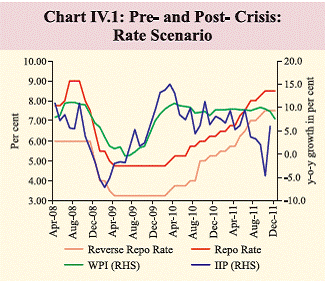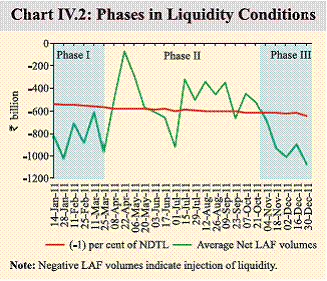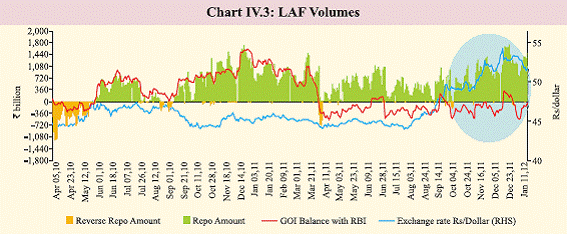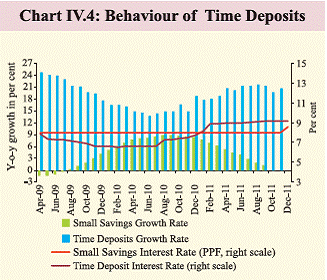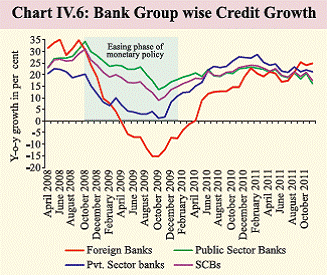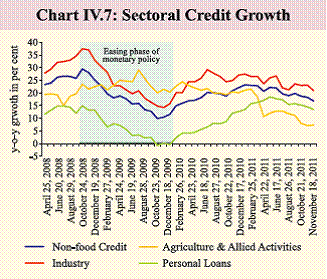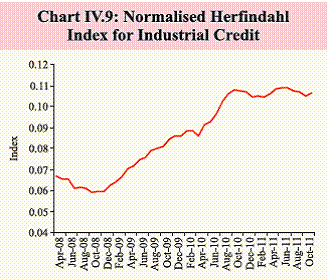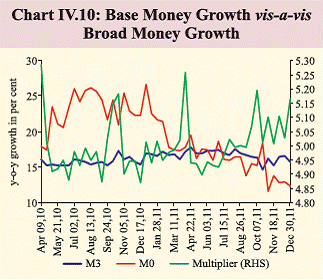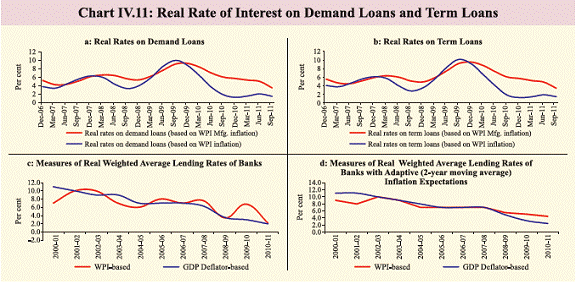 IST,
IST,
IV. Monetary and Liquidity Conditions
Factoring in increased downside risks to growth and expected moderation in inflation, monetary policy rate was kept on hold in December 2011. The trajectory of the monetary cycle would be shaped by evolving growth-inflation dynamics. During Q3 of 2011-12, credit growth slowed down partly reflecting the slowing economic activity and the portfolio adjustment to the Non-Performing Assets (NPA) cycle. On the monetary side, the rising money multiplier has kept the broad money growth at high levels despite low reserve money creation. Money market rupee liquidity, however, tightened partly as Reserve Bank sold dollars to contain exchange rate pressures. The liquidity stress was handled by the Reserve Bank by injecting liquidity through open market operations (OMO), including repos under the LAF, to balance the demand for liquidity. Monetary space to support growth exists, but pace of action will depend on evolving growth-inflation dynamics IV.1 The anti-inflationary monetary policy stance adopted since early 2010 continued till October 2011 as the Reserve Bank carefully calibrated policy response to the dilemma of anchoring inflationary expectations while ensuring that the growth impulses of the economy are not hampered. Factoring in the switchover from reverse repo mode to repo mode, the effective policy rate tightening was 525 bps during this period. In continuation of this policy stance, the Reserve Bank raised the policy repo rate by 25 bps to 8.5 per cent in October 2011 (Table IV.1). Subsequently, however, while inflation remained on its projected trajectory, downside risks to growth increased due to global risks and domestic policy uncertainties. Consequently, policy rates were kept unchanged in the Mid-Quarter Review on December 16, 2011 (Chart IV.1). IV.2 The global economic outlook has weakened considerably in recent weeks. While the recent moderation in inflation may provide some policy comfort, monetary policy actions ahead will depend on the evolving dynamics between growth and inflation. RBI infuses liquidity as rupee and dollar liquidity tightens IV.3 The Liquidity Adjustment Facility (LAF) has remained in injection mode since June 2010, in line with the stated policy objective of the Reserve Bank. During this period the antiinflationary monetary policy stance was supported by deficient liquidity conditions. Monetary transmission is usually more effective in a deficit liquidity situation, as money market rates respond immediately to a policy shock. The extent of liquidity deficit, however, was not uniform throughout this period with the drivers of liquidity changing over time.
IV.4 Three broad phases for the year 2011 can be identified: first phase from January 2011 till end-March 2011, when frictional factors like large government cash balances with the Reserve Bank and structural factors like imbalances in deposit and credit growth and above trend growth in currency resulted in severe liquidity pressure (Chart IV.2). IV.5 Subsequently, in the second phase during end-March 2011 to mid-October 2011, the liquidity pressure moderated as both structural and frictional liquidity drivers eased (Table IV.2). The average daily LAF injection came down to `476 billion during this period. During the above period, liquidity deficit largely remained within the comfort zone of the Reserve Bank. The main factors behind this easing of liquidity pressure were the drawdown of government cash balances and narrowing divergence between credit and deposit growth. IV.6 In the current phase, which began since mid-October 2011, pressures on liquidity reemerged with the decline in the level of WMA/OD and the forex market operations conducted by the Reserve Bank (Chart IV.3). Consistent with the stance of monetary policy and based on the assessment of prevailing and evolving liquidity conditions, the Reserve Bank undertook several measures to alleviate the liquidity pressure. These include open market purchases, additional repo on December 16, 2011 and MSF facility being extended against excess SLR holdings. The pressure on liquidity has persisted in January 2012 so far. During the current financial year liquidity amounting to ` 614 billion have been injected under the OMOs till January 16, 2012. Some banks also tapped the MSF window during December 2011 and January 2012.
IV.7 The domestic liquidity deficit has remained significantly above the Reserve Bank’s comfort zone of 1 per cent of NDTL since November 2011. Even though liquidity deficit was largely beyond this zone during this third phase, the new operating procedures introduced in May 2011 helped keep money market stress under check. The short-term rates were less volatile and remained largely anchored within the corridor set by the reverse repo rate and the MSF rate. In earlier periods of similar liquidity mismatches, the spikes in short-term rates were much larger. The Reserve Bank’s timely policy actions of providing liquidity without compromising on the antiinflationary policy objective or funding speculative positions in the foreign exchange market, also helped in limiting pressures on short-term rates. Going forward, liquidity deficits need to be addressed in a calibrated manner.
IV.8 Currently, the holding of government securities by the banking system is around 29 per cent of NDTL, which is nearly five percentage points above the statutory requirement. This provides a relatively large scope for liquidity infusion. The OMOs have been an instrument of first preference for the purpose, but additional instruments could be considered as and when required. Currency expansion moderates, but deposit growth remains firm, aided by interest rate cycle IV.9 Currency growth, which witnessed a sharp increase in 2010-11 on account of strong rebound in economic growth coupled with inflationary pressures, has been decelerating in 2011-12 so far. The deceleration in currency growth can be attributed to economic agents’ response to the high opportunity cost of holding money as interest rates on deposits increased. A substitution from currency to term deposits is evident in the current financial year so far. IV.10 The term deposits have been registering robust growth since December 2010 due to successive hikes in interest rates (Chart IV.4). The mirror image of this growth was evident in the deceleration in currency growth and also in the sharp decline in demand deposit growth. Major reforms in the area of interest rates have been introduced by the Reserve Bank in the recent period. Effective October 25, 2011, the Reserve Bank deregulated the deposit rate on savings bank accounts. This move, besides improving the transmission of monetary policy, is also expected to bring saving deposit rates in sync with the changing market conditions.
Credit decelerating on cyclical considerations IV.11 Non-food credit growth has been generally showing a decelerating trend since December 2010. The recent deceleration reflects overall slowdown in economic activity and some risk aversion by banks as well as impact of cumulative monetary actions taken so far. IV.12 The divergence between credit and deposit growth rate, which was high and growing during the first three quarters of 2010-11, has progressively narrowed since then (Chart IV.5). IV.13 At the broad bank group level, the deceleration in credit growth of the public sector banks was particularly sharp. This reflected rising risk aversion of these banks that is leading to portfolio switch to investments in risk-free G-secs on the back of large government market borrowing . As the public sector banks are the largest lenders in terms of outstanding credit, the deceleration in their credit growth pulls down the overall credit expansion of SCBs taken together. The credit growth of foreign banks, which had witnessed sharp decline during October 2008-October 2009 period, has witnessed a rebound since then. Private sector banks, which registered strong credit growth in the post-crisis period, have however witnessed a moderation in credit growth in recent period. (Table IV.3 and Chart IV.6).
IV.14 The deceleration in non-food credit growth since December 2010 is contributed by all the sectors, including industry, personal loans, services and especially agriculture (Chart IV.7). While the deceleration in agriculture is partly on account of definitional changes effected during February-March 2011, the high growth of NPAs in agriculture sector also possibly contributed to the slowdown (Chart IV.8). IV.15 During last two years, the growth rate of gross NPAs has remained high, even during the period when economic growth was robust. While the high NPA levels partly reflect implementation of better reporting system, the slippage remains a cause of concern.
IV.16 An analysis of credit flow to 19 industrial groups using a Normalised Herfindahl Index reveals that the concentration of industrial credit has increased over a period (Chart IV.9). On the positive side however, the present level of the index merely indicates transition from low to moderate concentration and to that extent the vulnerability of banks to particular sector specific shocks is limited. Rising money multiplier keeps monetary expansion in spite of low primary money creation IV.17 The deceleration in reserve money was led by a moderation in the demand for currency.Notwithstanding the sharp deceleration in reserve money growth, broad money supply growth has mostly remained above the indicative trajectory of the Reserve Bank (Chart IV.10).This is mainly on account of sharp growth in money multiplier and indicates a need to maintain a delicate balance between provision of liquidity and maintaining control thereupon to restrain inflation. The growth in money supply in Q3 of 2011-12 is led mainly by growth in time deposits on the component side (Table IV.4). This growth in time deposits was mainly on account of rising opportunity cost of holding cash or demand deposits as the interest rates on time deposits responded to the anti-inflationary monetary policy stance of the Reserve Bank. On the sources side the rise in broad money supply was led by increase in net RBI credit to government sector, reflecting OMO and LAF operations of the Reserve Bank.
Non-bank sources continue to dominate the flow of resources to the commercial sector IV.18 Non-bank sources, whose share in total flow of resources was 43.0 per cent in April- December 2010, are now the dominant sources of finance with its share close to 53.9 per cent. Within domestic financing, the number of public issues by non-financial entities has reduced substantially mainly reflecting the subdued trends in the stock market (Table IV.5).
Real interest rates remain low IV.19 In the recent period despite monetary tightening, real lending rates have remained low reflecting high inflation (Chart IV.11). Low but positive real lending rates paved the way for anti-inflationary stance to work, while allowing growth to moderate gradually Deteriorating macro-economy poses multiple challenges for monetary policy IV.20 With visible signs of slowdown, rate hikes were paused. While food inflation has since turned negative, this is mainly on account of the high base and seasonal fall in vegetable prices. The critical factors in rate actions ahead will be core inflation and exchange rate passthrough. At the same time enabling smooth functioning of other markets by ensuring that the liquidity deficit remains within acceptable limits is also a policy priority. The monetary policy stance in the near future needs to balance various considerations. |
||||||||||||||||||||||||||||||||||||||||||||||||||||||||||||||||||||||||||||||||||||||||||||||||||||||||||||||||||||||||||||||||||||||||||||||||||||||||||||||||||||||||||||||||||||||||||||||||||||||||||||||||||||||||||||||||||||||||||||||
পৃষ্ঠাটো শেহতীয়া আপডেট কৰা তাৰিখ:






